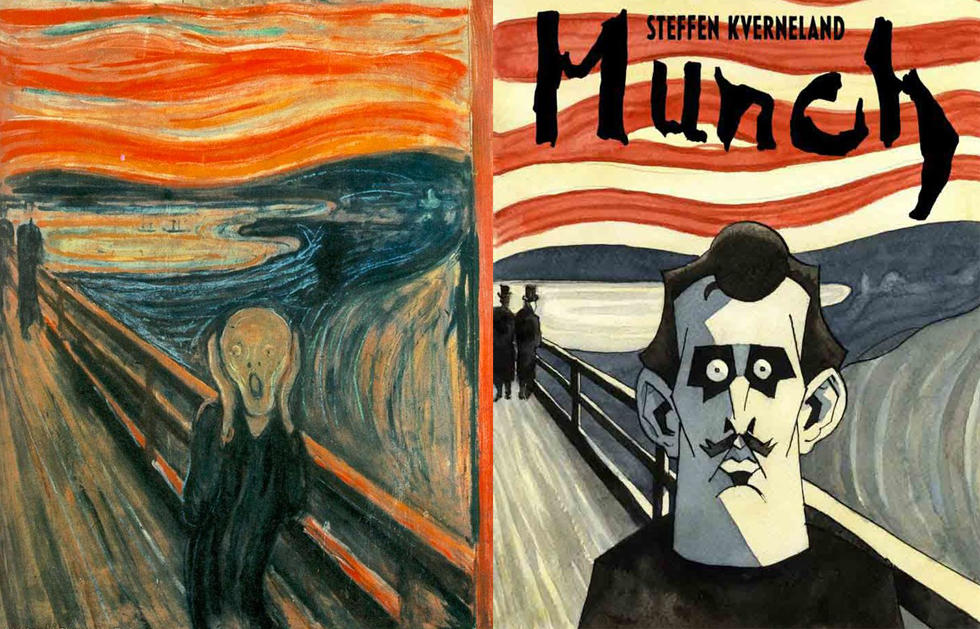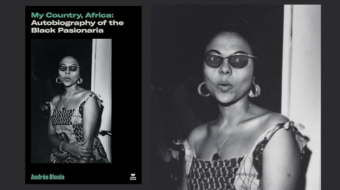
Edvard Munch’s The Scream (1893) speaks to us again today with great intensity. How did this painting come about? In September 1892, in Kristiana (present-day Oslo), Munch recorded a harrowing experience in his diary:
One evening I was walking out on a hilly path near Kristiania—with two comrades. It was a time when life had ripped my soul open. The sun was going down—had dipped in flames below the horizon. It was like a flaming sword of blood slicing through the concave of heaven. The sky was like blood—sliced with strips of fire—the hills turned deep blue the fjord—cut in cold blue, yellow, and red colors—The exploding bloody red—on the path and hand railing—my friends turned glaring yellow-white—I felt a great scream—and I heard, yes, a great scream—the colors in nature—broke the lines of nature—the lines and colors vibrated with motion—these oscillations of life brought not only my eye into oscillations, it brought also my ears into oscillations—so I actually heard a scream—I painted the picture Scream then. (The Private Journals of Edvard Munch, We Are Flames Which Pour Out of The Earth, edited and translated by J. Gill Holland, p. 64-65.)
Munch’s world-famous painting is based on this experience. His iconic figure hears a searing scream. But why has this painting become so indelibly engraved in the collective memory of the human community? How exactly is the horror captured in the painting?
It is unclear whether the figure only hears the scream or is also screaming in despair, but this seems likely. The hands cover the ears to protect them from the scream, but this gesture also manifests his own horror. As the artist states, this scream originates in nature; it is therefore something profoundly elemental.
The description in Munch’s diary is vivid and already contains aspects of the painting. Red and blood are mentioned several times; there are also references to flames, fire, even the fjord and the mountains are bathed in “the exploding bloody red.” The sky, dripping with blood, fire, and violence, takes up a third of the picture and radiates onto the dark mountains and the fjord, which primarily reflects the yellow color of the flaming sky and is framed by the mountains and the town of Kristiana in reddish brown and blue tones. The city itself is only hinted at.

The clearly recognizable, curved lines of the brushstrokes in oil and tempera, as well as highlights in pastel chalk, applied directly to the brown, unprimed cardboard, capture the movement and sound waves of the scream. This effect is reinforced by the contrasts of glaring yellow with crimson and dark. This clash of bright with broken colors infuses nature with a simultaneously horrific and ominous, impenetrable character.
The painful nature of the scream is emphasized by colliding forms: Vibrations, curves, and abysses dominate two-thirds of the picture; one-third is filled by the dead straight lines of the bridge and the horizontal struts of the railing. The picture is thus divided into two large, contrasting triangles: one belongs to the outcry of nature, which still also harbors people with its soft, flowing lines. The smaller triangle to the left of the horizontal struts of the bridge railing is characterized by taut, hard diagonals that run through the picture like an arrow. This collision between the softly curved waves and the hard diagonals makes the vibrations that the painter talks about in his diary almost audible.
A funnel shape of dark blue, within nature, whose tip runs towards the head of the screaming character, creates the sense of inescapable suction, like a black hole, of which only the horror-struck person is aware. The movement of the suction toward the skull suggests that the catastrophe is perceived by his consciousness alone, not by the other people in the picture, although the city of Kristiana is also caught up in the all-engulfing maelstrom. The barrier between the bridge and the abyss is quite open and offers no fall protection.
The skeletal head is in the center of the picture. Munch barely uses any color to create this face, leaving a large part of it simply on the unpainted brown ground. The mouth, wide open in horror, dominates the face, the nose and eyes are only indicated, white pastel chalk strokes trace the contours of the skull, the eye sockets, the jaws, and deepen the impression of a skeleton; the hands are also reminiscent of bones.
The rest of the body is sketchy: The figure’s jacket reflects the colors of the devouring funnel and becomes shapeless, disembodied from the chest down. The skull seems a little too large for the body, almost too heavy. While the head protrudes into the dark triangle above the railing, the body is located under the bridge railing with its straight lines into the upper third of the left edge of the picture. The triple struts of the railing thus connect the figure in the foreground directly with the two dark, walking figures a short distance away. Top hats point to two conventionally dressed, faceless men. It is unclear whether they are walking away from the viewer or one of them is coming toward them. These two men, toward whom the diagonal is pointing, are thus given an impulse to help the martyred person and are thereby included in the action. They, however, do not hear the scream—neither the despair of nature nor the shriek of their fellow human being. No help or empathy is forthcoming.
Another doubling, contrasting with the screaming individual, are the two boats seen on the fjord: a seemingly peaceful enjoyment of the evening, perhaps late fishing. Nature is not deserted, but includes human activity. Only the person screaming in deepest distress senses the impending apocalypse. So while fellow human beings are quite immune to the blood-soaked sky, for the tormented creature the world is in flames. Horror reigns beneath the surface of a peaceful world. Familiar signs can no longer be relied on: red, the color of love and warmth, now transports fire and blood. The sky is not a comforting sight, but deeply threatening. But only the artist realizes this. Munch wrote in pencil in a red stripe in the sky: “kan kun være malet af en gal mand” (“can only have been painted by a madman”). The painter worried all his life about losing his mind and also spent time undergoing psychiatric treatment. But the horror to which he sensitizes the eyes and ears of the viewer with this picture reflects the fears of the individual and at the same time captures the madness of an era that was heading for the abyss.
In his diary, Edvard Munch records a personal experience that deeply disturbed him. The painting has appealed to viewers on this private level also ever since. However, from our historical vantage point, a further dimension emerges that Munch and his contemporaries certainly did not realize and could only guess at. The Scream was created at the onset of the imperialist era, with its accompanying profound social and political upheavals. This is another reason why this work of art speaks to us with such poignancy today.
In the late 19th century, a new, more international, more aggressive stage of capitalism emerged. As the world was being redivided, with rapidly growing technological progress and simultaneously increasing urban impoverishment, the First World War cast its shadow long before. Munch lived in Berlin between 1892 and 1894. It is conceivable that his stay in this metropolis not long after the formation of the Reich under Bismarck when German imperialism was also rapidly gaining strength, intensified the painter’s perception of a disquieting time. Everything seemed to be spiraling out of control. Nihilism, which also affected Munch, gained new fertile ground with its anti-humanist idea of the meaninglessness of life. It suited the ruling class of the era that the world no longer seemed comprehensible.
The Irish poet William Butler Yeats reflected in 1919:
Turning and turning in the widening gyre
The falcon cannot hear the falconer;
Things fall apart; the centre cannot hold;
Mere anarchy is loosed upon the world,
The blood-dimmed tide is loosed, and everywhere
The ceremony of innocence is drowned;
The best lack all conviction, while the worst
Are full of passionate intensity.
When Yeats wrote these lines, imperialism had already wreaked the first great world war. Munch experienced the emergence of this new, imperialist stage of capitalism as a young adult. Simplified, Lenin wrote, imperialism could be defined as follows:

Imperialism is capitalism at that stage of development at which the dominance of monopolies and finance capital is established; in which the export of capital has acquired pronounced importance; in which the division of the world among the international trusts has begun, in which the division of all territories of the globe among the biggest capitalist powers has been completed. (Imperialism, the Highest Stage of Capitalism)
According to Lenin, imperialism emerged as a specific phase of capitalism between 1873 (not yet established) and 1900 (established):
(2) After the crisis of 1873, a lengthy period of development of cartels; but they are still the exception. They are not yet durable. They are still a transitory phenomenon. (3) The boom at the end of the nineteenth century and the crisis of 1900-03. Cartels become one of the foundations of the whole of economic life. Capitalism has been transformed into imperialism.
Based on these corner dates, it can be posited that Munch’s world-famous painting from 1893 artistically captures this transition to imperialism. This is not to claim that the painter himself was aware of such a thing, but rather that Munch’s great sensitivity achieved what Shakespeare expected of true art: “to show…the very age and body of the time his form and pressure” (Hamlet, Act III, scene 2).
Naturally, personal sensibilities inform a work of art, but its paramount importance lies in the fact that Munch—by facing his own fears, his own pain—was able to express this scream of the tortured creature as a defining moment of the age in such a way that people all over the world are still moved today.
So while the subject matter of the painting depicts exactly what most establishment art critics describe, namely a person standing on a bridge near Oslo and hearing a scream that affects him existentially (and shrieking himself), the time of the painting’s creation contributes decisively to its significance. The scream as an essential part of the subject therefore logically shapes the colors, the composition, the structure, the tensions, which heighten it and move it toward horror and despair. In the form of his painting, Munch breaks away from Impressionism and describes a world torn apart, from the perspective of personal perception. Art enters the age of imperialism.
The artist created four further versions of the painting, as well as a lithograph. Since its creation 130 years ago, Munch’s picture, like the Mona Lisa or Guernica, has been engraved in the visual memory of humankind. Munch’s painting vividly evokes in us an empathy that defines our humanity, which we feel when we hear about natural disasters and personal tragedies, but above all about the immense suffering and terror of martyred people in war zones. Munch’s desperate, screaming face is captured three times in Picasso’s Guernica (1937)—in the mother with the dead baby, the person in flames, the tortured horse, scenes that continue to be caused by imperialist violence and wars today. Munch gave artistic expression to this horror. We see ourselves in this picture and at the same time recognize the humanist feeling that unites us all in humanity—solidarity and compassion. The Scream expresses deep emotionality and humanity that define its greatness.
I would like to thank Friederike Riese and Erwin Ritzer for their valuable advice.
We hope you appreciated this article. At People’s World, we believe news and information should be free and accessible to all, but we need your help. Our journalism is free of corporate influence and paywalls because we are totally reader-supported. Only you, our readers and supporters, make this possible. If you enjoy reading People’s World and the stories we bring you, please support our work by donating or becoming a monthly sustainer today. Thank you!










